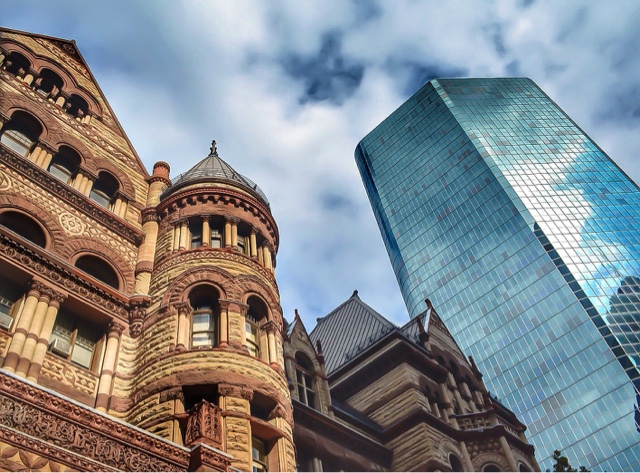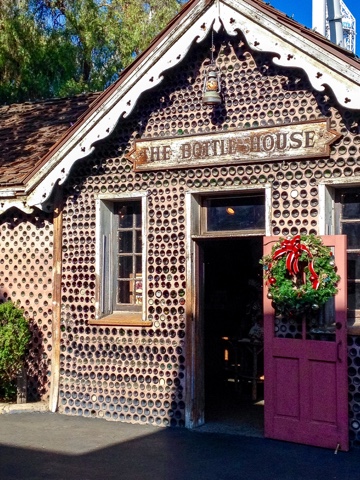Located at the corner of Queen and Bay Street in the centre of downtown Toronto, Old City Hall was completed in 1899. The building was designed by prominent Canadian architect Edward James Lennox, who is responsible for designing over seventy buildings in Toronto. It took over a decade to build and cost 2.5 million dollars to construct. The building was designed in a slight variation on the Romanesque Revival architecture, known as Richardsonian Romanesque. Developed by the prominent American architect, Henry Hobson Richardson, Richardsonian Romanesque is a free revival style that incorporates 11th- and 12th-century French, Spanish and Italian Romanesque elements. It has a strong emphasis on picturesque massings, rounded arches, cylindrical towers and conical caps.
Built primarily from sandstone, the Old City Hall features a two-tone façade. A light brown-grey sandstone provides one tone, and a dark reddish stone known as Sackville Sandstone is used as the contrast. The sandstone was transported to the site from quarries located in Westmorland County, New Brunswick. It took 1360 railroad loads to transport all the stone, needed to erect the building, to the site.
Situated at the front of the building is the clock tower. It was placed slightly off-centre to provide a terminating vista for Bay Street. The clock tower is 103.6m (340ft) high. The face of the clock has a 6m (20ft) diameter. There are three bells in the clock room, the largest one weighing over 5443kg. A glass room encloses the clock's mechanism. Although the clock originally functioned manually, it was automated in the 1950s. In more than a century the clock has only ever stopped once, and that was for maintenance in 1992. On the clock tower there are four gargoyles. In 1938, the original sandstone gargoyles were removed from the tower due to weather damage. Bronze cast gargoyles replaced the original ones in 2002.
The entire building has ornamentation reflecting ancient Roman art. Near the entrance to the building there are several grotesque carved faces. The architect Lennox included his own face on one of the carvings.
Bidding entrance to a two-storey main hall are three large oak doors. Entering the building there are murals designed by Canadian artist and painter George Agnew Reid. The murals depict Toronto Pioneers and Angels. A huge stained-glass window with three arches and twelve life-sized figures was created by Canadian stain-glass artist Robert McCausland to decorate the interior of the building. Entitled 'The Union of Commerce and Industry', the stained-glass window depicts the city's waterfront.
Despite the size of the Old City Hall, within a couple of decades of the building being completed it was no longer big enough to accommodate Toronto's growing municipal government. The then Mayor, Nathan Phillips, decided that a new building was required, and launched an international architectural competition to create a new City Hall. A striking Modernist City Hall and public square were completed in 1965. In the 1960s, plans for the Eaton Centre called for the demolition of Old City Hall. However, public outcry saved the building. Old City Hall was designated a National Historic Site of Canada in 1984.
There are supposedly over fifty spirits that haunt the Old City Hall in Toronto. Two of the most notorious ones are Ronald Turpin and Arthur Lucas, the last two men to be hanged in Canada. Executed in December 1962, the two were hanged at the same time. Turpin was convicted of killing Metropolitan Toronto Police Officer Frederick Nash, after the police officer pulled Turpin over for a broken tail-light as he was fleeing from a robbery. US-born Lucas was convicted of killing a US police informant in Toronto. The attending Chaplain is said to have revealed on his deathbed that the hangman got the weights wrong, and Lucas' head was almost ripped off when he was hung. These spirits reportedly haunt Courtroom 125 ( formerly known as Courtroom 33). Judges working in the building have heard unexplained noises and had their robes tugged at on the back staircase. Moans have been heard coming from the cellar, and a presence has been felt in the northwest section of the attic. Footsteps have been reported coming from empty hallways.
I think that Old City Hall is a magnificent building, and I was shocked to learn there was ever a time that anyone considered demolishing it. The building stands majestically amongst the more modern buildings of Toronto. I love the clocktower in particular.


























































